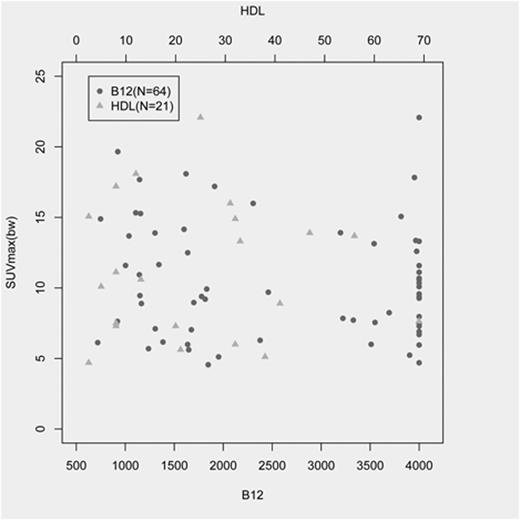Abstract
Introduction/Background:
The autoimmune lymphoproliferative syndrome (ALPS) is a disorder of impaired lymphocyte apoptosis commonly associated with defects in the FAS gene in the CD95 signaling cascade. Childhood onset lymphadenopathy, splenomegaly and autoimmune cytopenias are characteristic clinical presentation of ALPS. The immunophenotypical hallmark of ALPS is the expansion of "double negative" TCR-__+T lymphocytes (DNTs) that lack both CD4 and CD8 markers and when these cells comprise more than 1.5% of all circulating lymphocytes. Patients with ALPS are at increased risk for B-cell lymphoma.
Patients and Methods:
We sought to evaluate the lymphoproliferative burden of patients referred to our institution and meeting the diagnostic criteria for ALPS using FDG-PET scans over a 10year period. Readily available biomarkers like serum vitamin B12 and HDL have also been very useful in diagnosis and follow up of patients with ALPS-FAS.
Results:
We have performed 91 FDG-PET scans in 76 ALPS patients. Whole body PET scans were performed, extending from the pelvis up to the cervical nodal regions, starting at 90 minutes after the FDG injection. The longer uptake times were chosen to account for nonmalignant nature of the condition under study. This included patients with ALPS-FAS (n=71) who had a median standardized uptake value (SUV) of 7.87 (range: 3.8-13.73) and non-FAS patients (n=20) with a median SUV of 7.47 (range: 4.21-14.41); none of these patients had lymphoma on clinical evaluation and further follow-up. In addition, 3 ALPS-FAS patients with lymphoma who underwent an FDG-PET scan prior to therapy for lymphoma had SUVs of 11.78, 15.24, and 26.86, respectively. Here we share the SUVMax data from PET imaging and associated biomarker data (serum vitamin B12, n=64 and serum HDL, n=21) available from 64 patients with ALPS-FAS (Table 1). FDG-PET SUVMax did not statistically correlate with high serum vitamin B12 levels and low serum HDL (n=21) (Correlation coefficient -0.14 and -0.02 respectively). Younger ALPS-FAS patients with more prolific lymphoproliferation were noted to have higher serum vitamin B12 values and more FDG avid lymphadenopathy in our series (Correlation coefficient Ð 0.56 and 0.29 respectively).
Conclusions:
1. FDG accumulates in the lymph nodes of patients affected by ALPS, but we postulate that FDG may accumulate in higher concentrations in lymph nodes from ALPS patients that have undergone malignant transformation.
2. Clinical correlation including history of sudden onset focal enlargement of nodes and systemic symptoms is essential to suspect a diagnosis of lymphoma in ALPS-FAS patients as FDG-PET scans by themselves have limited utility in patients with background of nonmalignant lymphoproliferative disorders.
3. FDG-PET/CT may aid the early detection of lymphoma in this at-risk population, as ALPS patients have a predisposition to develop malignancies, and choosing the most FDG avid lymph nodes for biopsy may reduce the need for repeat biopsies in response to lymph node size changes commonly observed in ALPS patients.
4. For diagnosis as well as assessing lymphoproliferative burden during long term follow up of ALPS-FAS patients both high serum vitamin B12 levels and lipid profile (low serum HDL) can be used as surrogate biomarkers even though they do not correlate very well with FDG avidity of their lymph nodes (Figure1) in the limited series presented here*.
*Reference: Moraitis AG, Freeman LA, Shamburek RD, Wesley R, Wilson W, Grant CM, Price S, Demosky S, Thacker SG, Zarzour A, Hornung RL, Pucino F, Csako G, Yarboro C, McInnes IB, Kuroiwa T, Boumpas D, Rao VK, Illei GG, Remaley AT. Elevated interleukin-10: a new cause of dyslipidemia leading to severe HDL deficiency.J Clin Lipidol. 2015 Jan-Feb;9(1):81-90. PMID: 25670364.
No relevant conflicts of interest to declare.
Author notes
Asterisk with author names denotes non-ASH members.



This feature is available to Subscribers Only
Sign In or Create an Account Close Modal